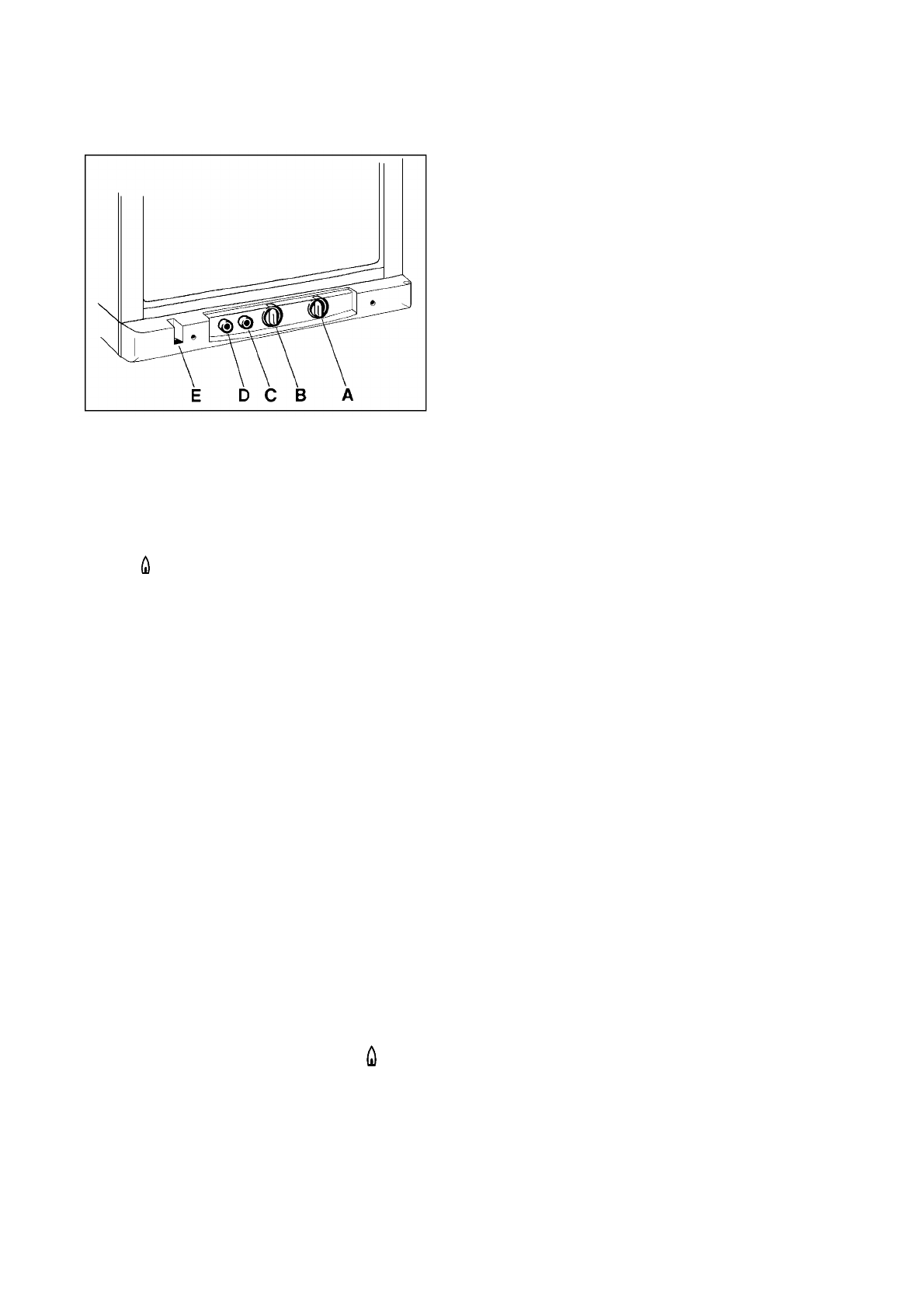
OPERATING INSTRUCTIONS
CONTROLS
FIG. 1
The refrigerator can be run on either mains electric or
LP gas. Changing between these modes of operation is
carried out by means of control buttons positioned as
shown in fig. 1.
The energy selector (A) can be set at either I (= mains
electric), (= LP gas) or 0 (= off).
The refrigerator temperature is controlled by a thermo-
stat (B). Please note that the thermostat has no "off"
position.
The refrigerator is fitted with a safety device which auto-
matically shuts off the supply of gas if the flame goes
out. The safety device can be opened manually by
depressing knob (C).
The piezoelectric igniter discharges sparks over the
burner when the button (D) is depressed.
In the flame viewer (E) you can see a blue light when the
flame is alight.
STARTING THE REFRIGERATOR
The position numbers refer to fig. 1.
LP Gas operation
After initial installation, servicing, or changing gas cylin-
ders etc., the gas pipes may contain some air which
should be allowed to escape by briefly turning on the
refrigerator or other appliances. This will ensure that the
flame lights immediately.
1. Make sure that all valves between the gas container
and the refrigerator are open.
2. Turn the energy selector (A) to position .
3. Depress the safety device control (C) and hold it
down while depressing the piezoelectric igniter but-
ton (D) repeatedly.
4. Check the flame indicator (E) to see whether the
flame is alight.
5. Keep the safety device control depressed for a further
10-15 seconds.
6. Release the safety device control and again check to
see that the flame is alight.
To terminate gas operation, turn knob (A) to 0.
Electric Operation
• Set the energy selector (A) to position I.
REGULATING THE TEMPERATURE
The position number refers to fig. 1.
It will take several hours for the refrigerator to reach
normal operating temperature.
The temperature of the main compartment of the refrig-
erator is controlled by a thermostat. The thermostat knob
(B) should be set at 3-5. If a lower (colder) temperature
is desired, set the thermostat to a higher figure.
DEFROSTING
Frost will gradually accumulate on the refrigerating sur-
faces. It must not be allowed to grow too thick as it acts
as an insulator and adversely affects refrigerator perfor-
mance.
Check the formation of frost regularly every week and
when it gets about 3 mm thick, defrost the refrigerator.
To defrost the refrigerator, turn it off and remove all items.
Do not try to accelerate defrosting by using any kind of
heating appliance, as this might damage the plastic
surfaces of the refrigerator. Neither should any sharp
objects be used to scrape off the ice.
The defrost water runs from a collector channel to a
receptacle at the rear of the refrigerator where it evapo-
rates.
Defrost water in the freezer compartment should be
mopped up with a cloth. When all ice has melted, wipe
the refrigerator dry and restart it.
CLEANING THE REFRIGERATOR
Clean the inside of the refrigerator regularly to keep it
fresh and hygienic.
Soak a cloth in a solution consisting of a teaspoon of
bicarbonate of soda to half a litre of warm water. Wring
out the cloth and use it to clean the interior of the
refrigerator and its fittings.
Never use detergents, scouring powder, strongly scen-
ted products or wax polish to clean the interior of the
refrigerator as they may damage the surfaces and leave
a strong odour.
The exterior of the refrigerator should be wiped clean
now and again, using a damp cloth and a small quantity
of detergent. But not the door gasket, which should only
be cleaned with soap and water and then thoroughly
dried.
The cooling unit behind the refrigerator should be clea-
ned with a brush from time to time, but make sure that
the refrigerator is switched off when doing this.
4


















